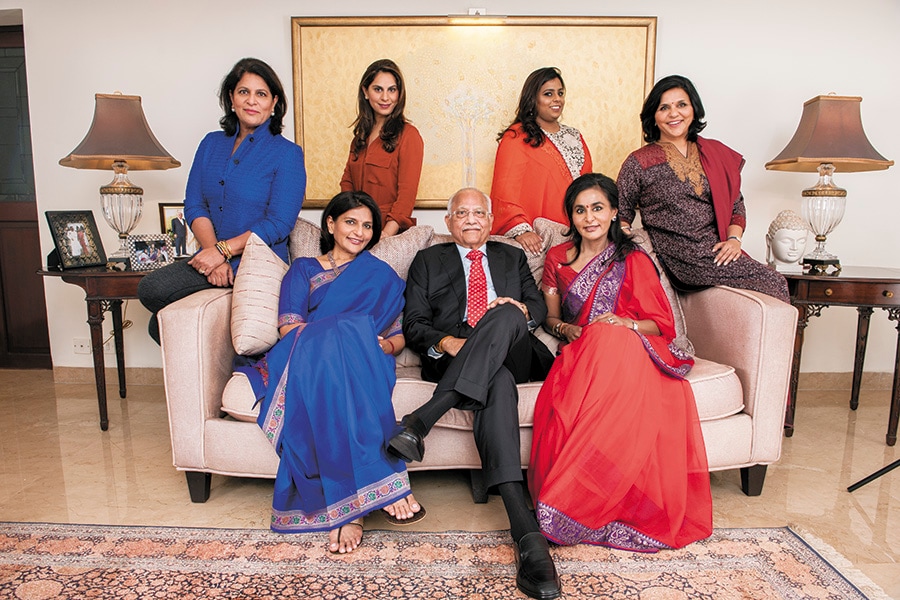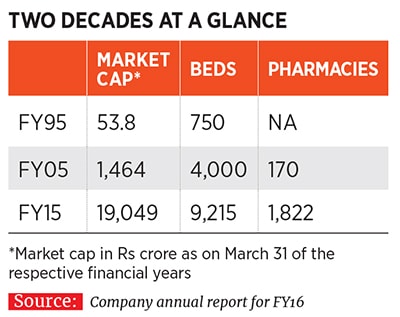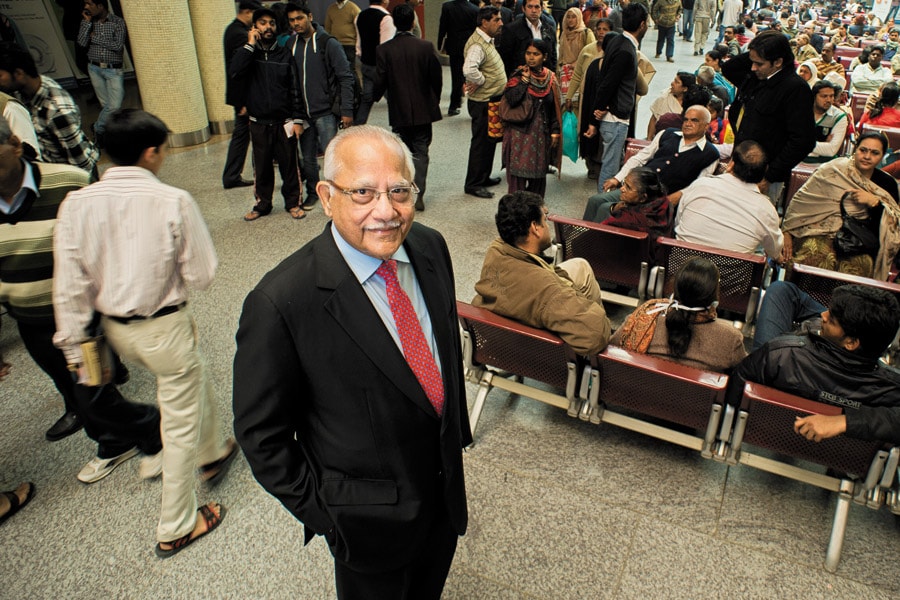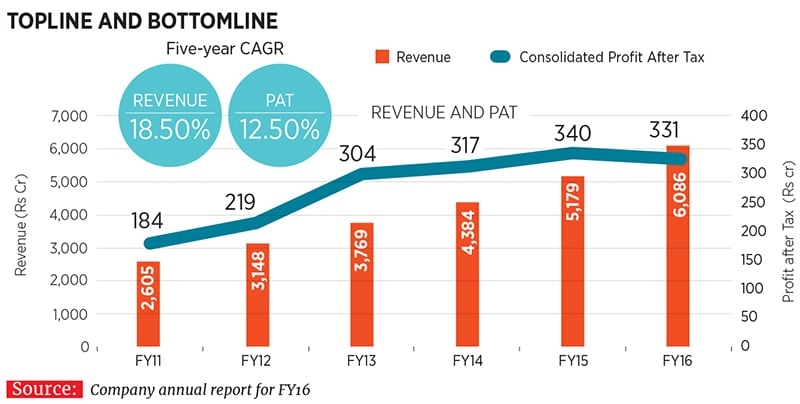
How Dr Prathap Reddy avoids ambiguity on succession and structure at Apollo Hospitals
At 84, Dr Prathap C Reddy still holds the casting vote at the Rs 6,000-crore, Chennai-based Apollo Hospitals Enterprise Ltd. And with the setting up of a family constitution on February 1, he is ensuring it passes on over generations to come
 (Behind, left to right) Shobana Kamineni, Upasna Kamineni, Sindoori Reddy and Sangita Reddy. (Seated, left to right) Preetha Reddy, Dr Prathap C Reddy and Suneeta Reddy
(Behind, left to right) Shobana Kamineni, Upasna Kamineni, Sindoori Reddy and Sangita Reddy. (Seated, left to right) Preetha Reddy, Dr Prathap C Reddy and Suneeta Reddy
Image: Vikas Khot
On February 1 this year, Dr Prathap C Reddy, founder and executive chairman of Apollo Hospitals Enterprise Ltd (AHEL), and his wife Sucharitha Reddy celebrated their 60th wedding anniversary in Chennai. Almost the entire family—including four daughters, 10 grandchildren and three great grandchildren—was in attendance. Not only for the momentous personal occasion, but also because the day held significance for the legacy of their family business, nurtured for over four decades by the 84-year-old patriarch.
“That’s the date of our [family] constitution—a preamble of dad’s wish, ideas, vision, and how we would all stay together. We actually signed a memorandum of understanding [on that day],” Shobana Kamineni, executive vice chairperson of AHEL, tells Forbes India. Shobana, 56, is Reddy’s third daughter and employee number 2 or 3—she’s forgotten which one—at AHEL. “All that is being done now [on the constitution] is the fine-tuning and the legality of it.”
This is an expected step by Reddy, who has avoided ambiguity on succession and structure issues from the get-go. Three years ago, he had spoken to Forbes India about a rotating chairmanship model for his four daughters. Now, defining how the family should work together has taken on greater significance with some of his grandchildren assuming key roles at AHEL.
However, the entry of the third generation into the family business would be on merit and based on their “natural affinity” towards health care, says Preetha Reddy, 59, executive vice chairperson of AHEL and the eldest daughter, who will be the next executive chairperson as per the family constitution.
But Reddy is not just trying to preserve a legacy. He wants the future generation to build on it. Because he remembers how it all started.
The first 150-bed multi-specialty Apollo Hospitals was operationalised on Greams Road, Chennai (then Madras), in 1983, with an investment of Rs 30 crore. Of that, Rs 5 crore was spent on importing and installing a CT scan machine. A large portion of the project cost was taken on loan from five public sector banks, after a go-ahead from then Union Finance Minister Pranab Mukherjee. About Rs 3 crore was secured through foreign exchange borrowings from American Express.
Thirty-four years on, the Apollo Hospitals growth story has become a case study at American universities. “My son who goes to college in the Boston area said his graduating class actually had to do the Apollo Hospitals case study,” says Shobana. In fact, Harvard Business School has done at least two case studies on AHEL—first in the late ’80s and early ’90s, and then again in 2000. “The original study by Harvard was a bit sceptical on whether this man [my father] could do it [build a profitable corporate hospital chain]. But when they came back in 2000, it [AHEL] was a very powerful [health care] model,” she says.
“The group has led various innovations—new business models beyond multi/super specialty hospitals; clinics for primary care; diabetes care; dental and birthing centres; telemedicine; and retail pharmacies, among other plays. Each of these plays has become a pioneer in their respective industry segments,” says Prashant Jain, director-health care, at investment bank o3 Capital.
This reflects in the numbers. For FY16, the company reported a profit of Rs 331 core on a revenue of Rs 6,085.6 crore, registering a year-on-year decline of 2.61 percent and a growth of 17.5 percent respectively. And for the April to December period of FY17, revenues (standalone) stack up at around Rs 4,800 crore with a profit of approximately Rs 240 crore.

AHEL, with just one operational hospital in Chennai, was the first corporate hospital in India to be listed in 1983 and raised Rs 1.7 crore. Today, adds Jain, it is the most valuable hospital company in India with a market cap of approximately $2.8 billion. “From shareholders’ returns perspective, Apollo Hospitals has returned 22 percent annualised returns for the last 20 years,” he says. At Rs 1,315.90 apiece as of March 3, the company’s share price has seesawed between Rs 1,412.15 and Rs 1,143.55 over the last 15 months.
With over 10,000 beds across 71 locations in India and abroad (two hospitals, one each in Dhaka and Muscat) in service, apart from pharmacies, primary care and diagnostics clinics, and telemedicine units, AHEL, which provides care in over 55 specialities at its larger hospitals, is now working on its next big project: A Rs 1,000-crore cancer treatment and research facility, Proton Treatment Centre, in Chennai, which is expected to become operational in 2018.
The facility will give patients access to the cutting-edge Proton Beam Therapy, which is an advanced radiation treatment for removing tumours (the malignant ones) from the head, neck, brain, pancreas and prostrate. It also aims to develop cancer control strategies such as finding newer methods in cancer prevention, diagnosis and treatment. This is among many firsts by AHEL. Since 2012, the hospitals have performed over 3,000 robotic surgeries.
AHEL has also entered into a collaboration with Singapore-based venture capital fund Jungle Ventures, which is investing in health care startups. For this, AHEL is setting aside a small investment corpus. The intent of this tie-up is to test the practical applicability and scalability of what these health care startups are creating, within the Apollo network.
A Turning Point
After getting his MBBS from Stanley Medical College in Chennai, Reddy, in 1961, joined the Worcester City Hospital, Massachusetts, where he was the resident doctor for two years and chief resident doctor for a year. He followed this up with a fellowship in cardiology at Massachusetts General Hospital, Boston (1964-1966), after which he was involved in research programmes at the Missouri State Chest Research Hospital.
He returned to India in 1970 and joined HM Hospital, a new 40-bed facility in Chennai. “By the third year I was very busy. Even people who had had heart attacks, but never came to us, used to come to me for opinions,” recalls Reddy, who would see about 30 to 40 patients a day. Even as he grew in stature as a cardiologist, it was an incident in 1979 that changed his life forever.
A 38-year-old patient of Reddy’s lost his life, leaving behind his wife and two children. “That scene flashes back to me: The wife on one side and the two children on either side of her, hugging their mother and crying,” says Reddy. The man could not raise enough money to go overseas for a bypass surgery. “Few hospitals were doing it in India then, but even that [standard] was not acceptable. I thought how many more people are going to die because how many can raise thousands of dollars to travel abroad for treatment? Only the rich and powerful could afford it then.”
 The dismal health care situation prompted Dr Prathap Reddy, founder and executive chairman of Apollo Hospitals, to build multi-specialty hospitals
The dismal health care situation prompted Dr Prathap Reddy, founder and executive chairman of Apollo Hospitals, to build multi-specialty hospitals
Image: Amit Verma
Thereafter, he was a man with a mission. For the next four years, he was single-minded about building a multi-specialty for-profit, private hospital in Chennai. There were, of course, the inevitable hurdles in terms of government regulations. Medical equipment carried a customs duty of 370 percent and funding for building hospitals was not readily available from banks, while foreign capital was not allowed.
In early 1982, the late Congress Party leader GK Moopanar facilitated a meeting for Reddy with then Prime Minister Indira Gandhi. He took the opportunity to apprise her of the dismal health care situation. “I told her that the powerful people in the country get a free Air India ticket and as far as the rich are concerned, it doesn’t matter what it costs. But for all the others, there is no good care in India—government hospitals can’t afford quality care and private hospitals don’t have good facilities,” he remembers telling her.
Over the next 24 months, he made over 50 trips to New Delhi to get various approvals and sanctions to start his first hospital in Chennai. In the process, he developed a good rapport with Indira Gandhi and later with her son Rajiv. He had even invited her to inaugurate the first hospital in Chennai in 1983, but she declined, asking him to request then President Giani Zail Singh instead.
“The movement of organised health care and corporate hospitals in India, which also led to an unprecedented wave of entrepreneurship in this sector, clearly rose with Dr Reddy,” says Vishal Bali, chairman, Medwell Ventures, a speciality home health care service provider and former CEO of Fortis Healthcare Ltd. “His vision for health care has been transformative.”
Of Early Starts
While Reddy was working the corridors of power in New Delhi, his four daughters—Preetha, Suneeta, Shobana and Sangita—were playing a pivotal role in helping their father achieve his dreams. In fact, points out Preetha, their baptism began much earlier, when Reddy was practising at HM Hospital.
“We love telling him that we were cheap labour,” smiles Preetha. Every Sunday, between 11 am and 1 pm, the girls were tasked with talking to patients and finding out what needed to be improved at HM Hospital. The first negative feedback they got was about the toilets—they were terrible! On learning this, Reddy spent from his own pocket to fix them. “At Apollo, all of us always check the bathrooms because it has been ingrained in us for so long,” says Sangita, 54, joint managing director, AHEL, and the youngest of the four siblings.
Over the weekends too, the girls were put to work. They had to escort patients, who would come for check-ups, from test to test.
Patient care, to that extent, became a way of life. “If there was somebody who was extremely sick, we were living and breathing that [situation], because dad was worrying about it and mom was praying for that patient,” says Preetha, who wanted to become a doctor. She had even secured a seat at the prestigious Madras Medical College, but Reddy dissuaded her from taking it up. He had wanted her to get married, “settle down”, as it were. Preetha then got married at the age of 19, and was the last of the four siblings to formally join AHEL in 1989 as joint managing director. In 1993, she was elevated to the post of managing director which she held till 2014. Under her stewardship, the company’s revenue grew from a mere Rs 25.18 crore (in the 18-month period between 1989 and 1991) to Rs 3,884 crore (standalone) in FY2014.
(This story appears in the 30 November, -0001 issue of Forbes India. To visit our Archives, click here.)






